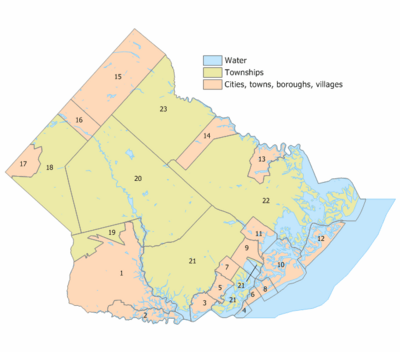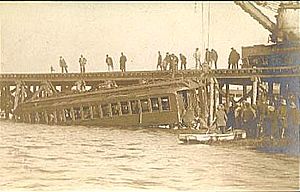Atlantic County, New Jersey facts for kids
Quick facts for kids
Atlantic County
|
||
|---|---|---|
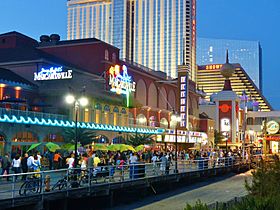
Atlantic City boardwalk at night
|
||
|
||
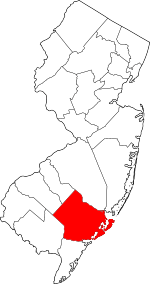
Location within the U.S. state of New Jersey
|
||
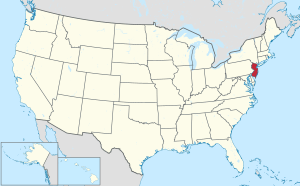 New Jersey's location within the U.S. |
||
| Country | ||
| State | ||
| Founded | 1837 | |
| Named for | Atlantic Ocean | |
| Seat | Mays Landing | |
| Largest municipality | Egg Harbor Township (population) Galloway Township (total area) Hamilton Township (land area) |
|
| Area | ||
| • Total | 671.83 sq mi (1,740.0 km2) | |
| • Land | 555.70 sq mi (1,439.3 km2) | |
| • Water | 116.12 sq mi (300.7 km2) 17.28% | |
| Population
(2020)
|
||
| • Total | 274,534 | |
| • Density | 408.636/sq mi (157.7753/km2) | |
| Congressional district | 2nd | |
Atlantic County is a county located along the southern coast of the U.S. state of New Jersey. As of the 2020 United States Census, the county had a population of 274,534, a -0.005 change from the 274,549 enumerated in the 2010 Census. Its county seat is the Mays Landing section of Hamilton Township. The most populous place was Egg Harbor Township, with 43,323 residents at the time of the 2010 Census; Galloway Township, covered 115.21 square miles (298.4 km2), the largest total area of any municipality, though Hamilton Township has the largest land area, covering 111.13 square miles (287.8 km2). Atlantic County forms the Atlantic City–Hammonton Metropolitan Statistical Area, which is also part of the Delaware Valley Combined Statistical Area.
Contents
History
All of what is known today as Atlantic County was once called Egg Harbor Township, the eastern half of the original County of Gloucester. Named as an official district as early as 1693, it was bounded on the north by the Little Egg Harbor River (now known as the Mullica River), and on the south by the Great Egg Harbor River and its southern branch the Tuckahoe River. Its eastern boundary was the Atlantic Ocean, but the western boundary in the South Jersey interior was not fixed until 1761. The county was formally created from portions of Gloucester County as of February 7, 1837, and consisted of the townships of Egg Harbor, Galloway, Hamilton and Weymouth.
Geography
According to the 2010 Census, the county had a total area of 671.83 square miles (1,740.0 km2), including 555.70 square miles (1,439.3 km2) of land (82.7%) and 116.12 square miles (300.7 km2) of water (17.3%).
Atlantic County is located in the Atlantic Coastal Plain in the southeastern part of New Jersey.
Topographically, much of Atlantic County is low-lying and flat. The highest elevation, approximately 150 feet (46 m) above sea level, is found at two areas next to the New Jersey Transit passenger rail line just west of Hammonton. Sea level is the lowest point.
Adjacent counties
Atlantic County borders the following counties:
- Burlington County, New Jersey – north
- Camden County, New Jersey – northwest
- Cape May County, New Jersey – south
- Cumberland County, New Jersey – southwest
- Gloucester County, New Jersey – northwest
- Ocean County, New Jersey – northeast
National protected areas
- Edwin B. Forsythe National Wildlife Refuge (part)
- Great Egg Harbor Scenic and Recreational River (part)
Demographics
| Historical population | |||
|---|---|---|---|
| Census | Pop. | %± | |
| 1840 | 8,726 | — | |
| 1850 | 8,961 | 2.7% | |
| 1860 | 11,786 | 31.5% | |
| 1870 | 14,093 | 19.6% | |
| 1880 | 18,704 | 32.7% | |
| 1890 | 28,836 | 54.2% | |
| 1900 | 46,402 | 60.9% | |
| 1910 | 71,894 | 54.9% | |
| 1920 | 83,914 | 16.7% | |
| 1930 | 124,823 | 48.8% | |
| 1940 | 124,066 | −0.6% | |
| 1950 | 132,399 | 6.7% | |
| 1960 | 160,880 | 21.5% | |
| 1970 | 175,043 | 8.8% | |
| 1980 | 194,119 | 10.9% | |
| 1990 | 224,327 | 15.6% | |
| 2000 | 252,552 | 12.6% | |
| 2010 | 274,549 | 8.7% | |
| 2016 (est.) | 270,991 | −1.3% | |
| Historical sources: 1790-1990 1970-2010 2000 2010 2000-2010 |
|||
Census 2010
As of the census of 2010, there were 274,549 people, 102,847 households, and 68,702 families residing in the county. The population density was 494.1 per square mile (190.8/km2). There were 126,647 housing units at an average density of 227.9 per square mile (88.0/km2)*. The racial makeup of the county was 65.40% (179,566) White, 16.08% (44,138) Black or African American, 0.38% (1,050) Native American, 7.50% (20,595) Asian, 0.03% (92) Pacific Islander, 7.36% (20,218) from other races, and 3.24% (8,890) from two or more races. [[Hispanic (U.S. Census)|Hispanic or Latino of any race were 16.84% (46,241) of the population.
There were 102,847 households out of which 29.8% had children under the age of 18 living with them, 45.6% were married couples living together, 15.5% had a female householder with no husband present, and 33.2% were non-families. 26.9% of all households were made up of individuals, and 10.8% had someone living alone who was 65 years of age or older. The average household size was 2.61 and the average family size was 3.17.
In the county, the population was spread out with 23.3% under the age of 18, 9.3% from 18 to 24, 24.6% from 25 to 44, 28.7% from 45 to 64, and 14.2% who were 65 years of age or older. The median age was 39.9 years. For every 100 females there were 94.2 males. For every 100 females ages 18 and old there were 91 males.
Census 2000
As of the 2000 United States Census there were 252,552 people, 95,024 households, and 63,190 families residing in the county. The population density was 450 people per square mile (174/km²). There were 114,090 housing units at an average density of 203 per square mile (79/km²). The racial makeup of the county was 68.36% White, 17.63% Black or African American, 0.26% Native American, 5.06% Asian, 0.05% Pacific Islander, 6.06% from other races, and 2.58% from two or more races. 12.17% of the population were Hispanic or Latino of any race. Among those residents listing their ancestry, 18.3% were of Italian, 17.3% Irish, 13.8% German and 7.7% English ancestry according to Census 2000.
There were 95,024 households out of which 31.70% had children under the age of 18 living with them, 46.50% were married couples living together, 14.80% had a female householder with no husband present, and 33.50% were non-families. 27.00% of all households were made up of individuals and 10.70% had someone living alone who was 65 years of age or older. The average household size was 2.59 and the average family size was 3.16.
In the county, the population was spread out with 25.30% under the age of 18, 8.10% from 18 to 24, 30.60% from 25 to 44, 22.40% from 45 to 64, and 13.60% who were 65 years of age or older. The median age was 37 years. For every 100 females there were 93.60 males. For every 100 females age 18 and over, there were 90.20 males.
The median income for a household in the county was $43,933, and the median income for a family was $51,710. Males had a median income of $36,397 versus $28,059 for females. The per capita income for the county was $21,034. About 7.6% of families and 10.50% of the population were below the poverty line, including 12.8% of those under age 18 and 10.50% of those age 65 or over.
Municipalities
Municipalities in Atlantic County (with 2010 Census data for population, housing units and area) are:
| Municipality (with map key) |
Municipal type |
Population | Housing Units |
Total Area |
Water Area |
Land Area |
Pop. Density |
Housing Density |
Communities |
|---|---|---|---|---|---|---|---|---|---|
| Absecon (11) | City | 8,411 | 3,365 | 7.29 | 1.90 | 5.40 | 1558.8 | 623.6 | |
| Atlantic City (10) | City | 39,558 | 20,013 | 17.04 | 6.29 | 10.75 | 3680.8 | 1862.2 | |
| Brigantine (12) | City | 9,450 | 9,222 | 10.36 | 3.98 | 6.39 | 1479.5 | 1443.8 | |
| Buena (17) | Borough | 4,603 | 1,855 | 7.58 | 0.00 | 7.58 | 607.4 | 244.8 | |
| Buena Vista Township (18) | Township | 7,570 | 3,008 | 41.53 | 0.47 | 41.05 | 184.4 | 73.3 | Collings Lakes CDP (1,706) Richland |
| Corbin City (2) | City | 492 | 212 | 8.94 | 1.28 | 7.67 | 64.2 | 27.7 | |
| Egg Harbor City (14) | City | 4,243 | 1,736 | 11.44 | 0.51 | 10.93 | 388.1 | 158.8 | |
| Egg Harbor Township (21) | Township | 43,323 | 16,347 | 74.93 | 8.34 | 66.6 | 650.5 | 245.5 | Jeffers Landing |
| Estell Manor (1) | City | 1,735 | 673 | 55.10 | 1.78 | 53.32 | 32.5 | 12.6 | |
| Folsom (16) | Borough | 1,885 | 717 | 8.44 | 0.24 | 8.2 | 229.8 | 87.4 | Penny Pot |
| Galloway Township (22) | Township | 37,349 | 14,132 | 115.21 | 26.14 | 89.07 | 419.3 | 158.7 | Pomona CDP (7,124) |
| Hamilton Township (20) | Township | 26,503 | 10,196 | 113.07 | 1.94 | 111.13 | 238.5 | 91.8 | Mays Landing CDP (2,135) |
| Hammonton (15) | Town | 14,791 | 5,715 | 41.42 | 0.53 | 40.89 | 361.8 | 139.8 | Dutchtown |
| Linwood (5) | City | 7,092 | 2,798 | 4.24 | 0.38 | 3.87 | 1834.9 | 723.9 | |
| Longport (4) | Borough | 895 | 1,656 | 1.56 | 1.17 | 0.39 | 2323.7 | 4299.4 | |
| Margate City (6) | City | 6,354 | 7,114 | 1.63 | 0.22 | 1.42 | 4490.3 | 5027.4 | |
| Mullica Township (23) | Township | 6,147 | 2,360 | 56.9 | 0.48 | 56.42 | 108.9 | 41.8 | Elwood CDP (1,437) Nesco |
| Northfield (7) | City | 8,624 | 3,260 | 3.44 | 0.04 | 3.40 | 2533.7 | 957.8 | |
| Pleasantville (9) | City | 20,249 | 7,219 | 7.30 | 1.60 | 5.69 | 3556.5 | 1267.9 | |
| Port Republic (13) | City | 1,115 | 444 | 8.58 | 1.10 | 7.48 | 149.0 | 59.3 | |
| Somers Point (3) | City | 10,795 | 5,556 | 5.16 | 1.13 | 4.03 | 2678.8 | 1378.7 | |
| Ventnor City (8) | City | 10,650 | 7,829 | 3.52 | 1.57 | 1.95 | 5457.4 | 4011.8 | |
| Weymouth Township (19) | Township | 2,715 | 1,220 | 12.45 | 0.36 | 12.09 | 224.6 | 100.9 |
Transportation
The indigenous people of New Jersey developed a series of trails across the state, including one from current-day Absecon to Camden. Early transportation relied on the region's waterways. An early coastal road was constructed in 1716 from Somers Point to Nacote Creek in Port Republic. Roads into the county's interior were slow, unreliable, and muddy, with one main roadway along the Mullica River that eventually connected to Burlington. Roads later connected the region's industries in the 19th century, until the county's first railroad opened in 1854, which brought more people to the region. By 1870, the Camden and Atlantic Railroad Company carried 417,000 people each year. Also in that year, the Pleasantville and Atlantic Turnpike opened, crossing Beach Thorofare into Atlantic City. A railroad competitor, the Philadelphia and Atlantic City Railway, opened in 1877 after only 90 days of construction. Other rail lines connected farms and cities throughout the county by the end of the 19th century. A notable railroad tragedy occurred on October 28, 1906, when three train cars derailed on a draw bridge into 30 ft (9.1 m) deep water in Beach Thorofare, with only two survivors. Improved roads reduced the reliance on railroads by the 1950s.
In the late 1800s, a bridge opened in Mays Landing, providing road access to the county's interior. The first car in Atlantic City was seen in 1899. By the 1890s, visitors began riding bicycles in the coastal resort towns, and thousands of people would ride from Camden to the coast on weekends. Amid pressure from motorists and cyclists, the county improved the conditions of the roads in the early 20th century. The first road bridge to Atlantic City opened in 1905, using Albany Avenue on what is now US 40/322. In 1916, the causeway that is now New Jersey Route 152 opened between Somers Point and Longport. In 1919, the White Horse Pike (US 30) was completed from Atlantic City to Camden, and repaved through the county in 1925. Also in 1922, the Harding Highway (US 40) opened from Pennsville Township to Atlantic City, named after then-President Warren G. Harding. In 1928, the Beesley's Point Bridge opened, replacing the ferry between Somers Point and Cape May County. The Black Horse Pike (US 322) opened in 1935, connecting Atlantic City to Camden. Most of the county's older bridges were replaced over time, although the oldest still in existence is a swing bridge from 1904 that crosses Nacote Creek in Port Republic. The Great Egg Harbor Bridge opened in 1956, marking the completion of the Garden State Parkway, which connected Cape May and Atlantic counties, continuing to North Jersey. In 1964, the Atlantic City Expressway opened between the Parkway and Camden County, and a year later was extended into Atlantic City. In 2001, the Atlantic City–Brigantine Connector was built, connecting the Expressway with Atlantic City's marina district.
As early as 1990, the South Jersey Transportation Authority had plans to construct an Atlantic County Beltway as a limited-access road, beginning along Ocean Heights Avenue in southern Egg Harbor Township at a proposed Exit 32 with the Garden State Parkway. The proposed road would pass west of the Atlantic City Airport and reconnect with the Parkway at Exit 44 via County Route 575 in Galloway Township. The routing was later truncated from U.S. 40 (the Black Horse Pike) to Exit 44 on the Parkway. The project was considered "desirable" but was not funded.
Roads and highways
As of 2010[update], the county had a total of 1,930.77 miles (3,107.27 km) of roadways, of which 1,357.05 miles (2,183.96 km) were maintained by the local municipality, 372.63 miles (599.69 km) by Atlantic County and 143.50 miles (230.94 km) by the New Jersey Department of Transportation and 57.59 miles (92.68 km) by either the New Jersey Turnpike Authority or South Jersey Transportation Authority.
Major highways
Major roadways include the Garden State Parkway (with 21.5 miles (34.6 km) of roadway in the county), the Atlantic City Expressway (29.6 miles (47.6 km)), U.S. Route 9, U.S. Route 30, U.S. Route 40, U.S. Route 206 and U.S. Route 322, as well as Route 49, Route 50, Route 52, Route 54, Route 87 and Route 152.
Public transportation
NJ Transit's Atlantic City Line connects the Atlantic City Rail Terminal in Atlantic City with the 30th Street Station in Philadelphia, with service at intermediate stations at Hammonton, Egg Harbor City and Absecon in the county.
Climate and weather
| Weather chart for Mays Landing, New Jersey | |||||||||||||||||||||||||||||||||||||||||||||||
|---|---|---|---|---|---|---|---|---|---|---|---|---|---|---|---|---|---|---|---|---|---|---|---|---|---|---|---|---|---|---|---|---|---|---|---|---|---|---|---|---|---|---|---|---|---|---|---|
| J | F | M | A | M | J | J | A | S | O | N | D | ||||||||||||||||||||||||||||||||||||
|
3.2
41
24
|
3
44
27
|
4.2
52
33
|
3.6
62
42
|
3.4
71
51
|
3.1
81
61
|
3.7
86
67
|
4.1
84
65
|
3.2
77
57
|
3.4
67
46
|
3.3
56
37
|
3.7
46
28
|
||||||||||||||||||||||||||||||||||||
| temperatures in °F precipitation totals in inches source: The Weather Channel |
|||||||||||||||||||||||||||||||||||||||||||||||
|
Metric conversion
|
|||||||||||||||||||||||||||||||||||||||||||||||
In recent years, average temperatures in the county seat of Mays Landing have ranged from a low of 24 °F (−4 °C) in January to a high of 86 °F (30 °C) in July, although a record low of −11 °F (−24 °C) was recorded in February 1979 and a record high of 106 °F (41 °C) was recorded in June 1969. Average monthly precipitation ranged from 2.99 inches (76 mm) in February to 4.21 inches (107 mm) in March.
Economy
Based on data from the Bureau of Economic Analysis, Atlantic County had a gross domestic product (GDP) of $12.9 billion in 2018, which was ranked 15th in the state and represented an increase of 3.5% from the previous year.
When Atlantic County was first established in 1837, its sparse population subsided on clams, oysters, and fishing. An early industry was shipbuilding, using the sturdy oak trees of the Pine Barrens. Bog iron furnaces opened in the early 1800s, but declined by the 1850s due to the growth of the Philadelphia iron industry. Around this time, several people and cotton mills opened. The first railroad across the county opened in 1854, intended to assist the bog iron industry; instead, it spurred development in Atlantic City, as well as the growth of farming towns. Farmers began growing grapes, cranberries, and blueberries. The competition dropped the price of travel to 50¢, affordable for Philadelphia's working class. Travelers often brought their lunch in shoe boxes, leading to their nickname "shoobies".
Legalized gambling and the growth of the casino industry employed more than 34,145 people as of 2012.
Breweries, distilleries, and wineries
In 1864, Louis Nicholas Renault brought property in Egg Harbor City and opened Renault Winery, the oldest active winery in New Jersey, and third-oldest in the United States. During the prohibition era, the winery obtained a government permit to sell wine tonic for medicinal purposes. Tomasello Winery grew its first vineyard in 1888, and opened to the public in 1933. Gross Highland Winery operated in Absecon from 1934 to 1987, when it was sold to developers. Balic Winery opened in 1966 in Mays Landing, although its vineyards date back to the early 19th century. Sylvin Farms Winery opened in 1985 in Egg Harbor City. In 2001, Bellview Winery opened in the Landisville section of Buena. A year later, DiMatteo Vineyards opened in Hammonton, and in 2007, Plagido's Winery opened in the same town.
In 1998, Tun Tavern Brewery opened in Atlantic City across from the Atlantic City Convention Center, named after the original Tun Tavern in Philadelphia, which was the oldest brew house in the country, opening in 1685. In 2015, Tuckahoe Brewing moved from Ocean View to a facility in Egg Harbor Township capable of producing four times the amount of beer. Garden State Beer Company opened in 2016 in Galloway. In 2018, Hidden Sands Brewery opened in Egg Harbor Township.
In 2014, Lazy Eye Distillery opened in Richland in Buena Vista Township. Little Water Distillery opened in Atlantic City in 2016.
See also
 In Spanish: Condado de Atlantic para niños
In Spanish: Condado de Atlantic para niños



